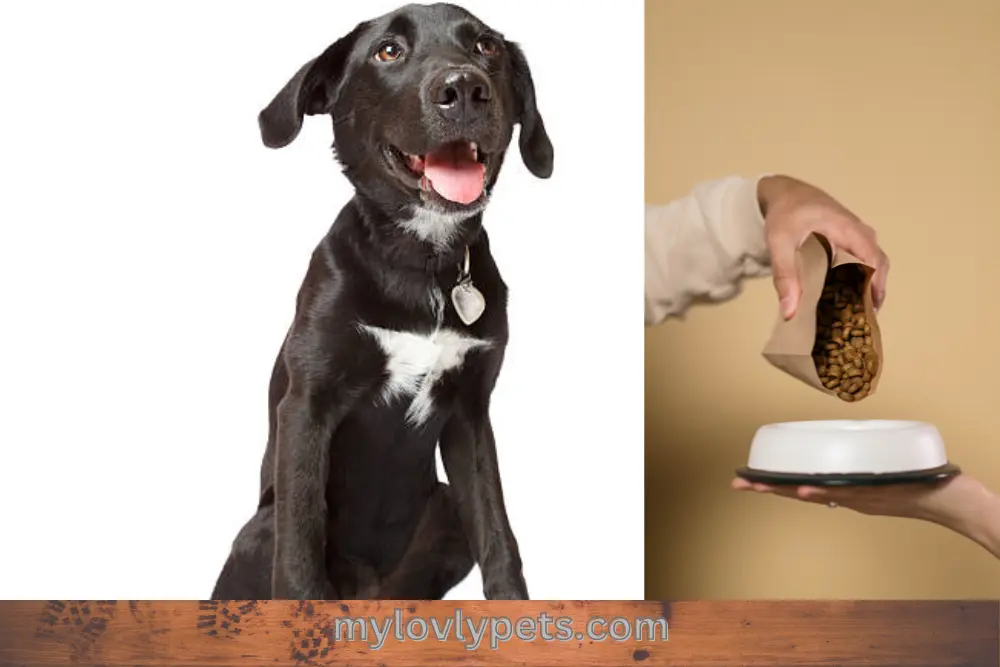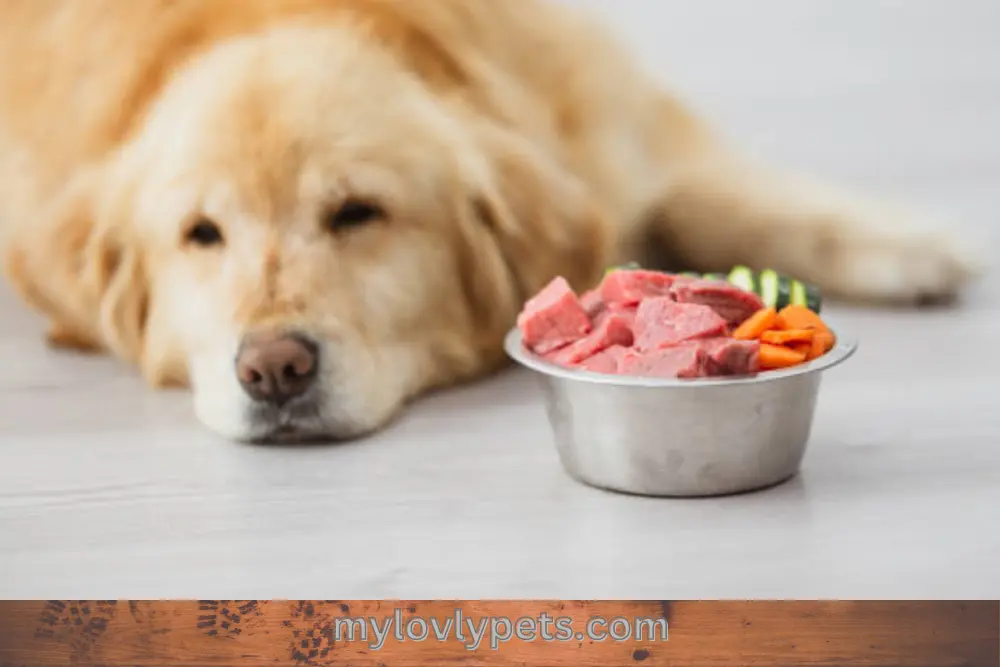
How To Train Your Dog To Wait For Food?( 3 Proven Method)
Teaching a dog to wait before eating food and treats is essential. It is possible with the help of a wait command, a leash, and a bowl. Positive reinforcement is key, and a dog trainer is always an option.
You may wonder how to train your dog to wait for food because they can get overly eager and hyperactive around mealtimes and treat times. Teaching your dog to be patient as you prepare their food will make feeding time more pleasant for both of you.
How to sit a dog
Teaching your dog to sit is an excellent first step in training your pet and can prove beneficial. Teaching your dog to sit at ques helps prevent accidents, and if you ask it to sit before greeting people, your dog is less likely to jump up on them.
Teach your dog to sit in easy steps

1. Hold a tasty treat close to your dog’s nose while standing.
2. Move your hand in an arc over your dog’s head while keeping the treat close to his nose. The dog’s bottom will hit the ground as his head lifts to follow the treat. As soon as he sits, give him the treat and the praise.
3.You should repeat this several times, each time for a shorter time.
4. You’ll notice he sits longer if you consistently reward your dog with a treat when he sits. As he sits down, you can now cue him with the command “sit.” Be careful not to say it before your dog gets into position, or they might associate it with the wrong action.
5. Repeated, brief, and consistent practice is recommended.
6. Let your dog know that the training session is over by using the “okay” command.
How to teach a dog to lie down
After your dog has learned “sit,” you should move on to teaching them “down.” You may use this trick at home or on the go whenever you need your dog to calm down and lie on the floor.
Train your dog to lie down in simple steps
1. With your dog seated, take the treat in your hand and slowly slide it from the dog’s nose to its chest and finally to the floor.
2. If your dog follows the treat, it should be in a lying-down pose. Please give them the treat and praise them right away.
3. Practice this many times in short but regular classes.
4.When your dog quickly follows the treat into the down position, you can start saying “down” just as your dog gets into the position.
5. Regularly practice this. Give your dog treats while he is lying down. This will make him stay down longer.
How to Teach Your Dog to Stay
Training your dog to ‘wait’ or “stay” is simple and can be very useful in keeping your dog safe. Before going on to “stay,” you’ll need your dog to be highly practiced at lying down on command.
How to Teach Your Dog to Stay Easy Steps

1. Order your dog to lie down
2. Show your dog a hand gesture, such as the “stop” sign (palm facing your dog), to get his attention.
3. Wait a few seconds before giving the treat to your dog. Say “stay,” then give it to them. Your dog should be rewarded while lying down, not after getting up.
4. Increase your dog’s time in the down posture by repeatedly practicing this in short, regular sessions.
5. The next step is gradually increasing the space between you and your dog. Start by taking one step back before rewarding them, then gradually increase it.
6. Practice in different places, like around the house, in the garden, at a friend’s house, and in the nearby park.
7. It’s best to work up to the length of time gradually you’d like your dog to stay. Regularly practice and add a few seconds.
8. Set your dog up for success by rewarding him before he breaks the “stay.”
How to Train Your Dog to Wait for Food
Dogs love getting treats and toys as rewards, but some get so excited about getting a reward that they forget how to be good dogs. There are methods to stop (and avoid) this impulsive behavior, whether your dog grabs at his food bowl when he’s eating or is overly aggressive with toys.
How to Train Your Dog to Wait for Food Easy Methods

Conditioning a dog to “wait” for treats.
Teach your dog a “wait” cue with her food bowl to prevent food bowl guarding or increase impulse control. Teaching your dog new behavior is more humane than being confrontational. So, here’s how it goes:
Food Bowl Method
1. First, hold the dog’s bowl at chest height and drop a treat inside.
2. Lower the bowl for him as your dog approaches his usual eating spot.
3. Do your best to bring the bowl to knee level without your dog jumping or rushing it. You may need to act swiftly to lower it low enough to tempt him.
4. You should raise the dog’s bowl rapidly if he attempts to jump or move quickly to get to it. The bowl should be raised enough that the dog cannot reach it. If the dog gets a hold of it, you’ll lose it.
5. However, if your dog waits patiently for you to bring the bowl down to knee level, you can take a piece of food out of the bowl and give it to him from your hand while praising him for his excellent behavior.
6. Repeat this several times without letting the bowl touch the floor; your goal is to raise the bowl to knee level without the dog jumping on you or rushing it.
Next Level
When you and your dog have reached the knee-level target and the dog is patiently waiting for his reward, move on to the next level.
Try lowering the bowl a few more inches until it’s only a few inches off the floor. Repeat the steps, bringing the bowl back up if your dog jumps or moves and giving him a treat if he behaves and waits.
Set a new objective of placing the bowl on the floor or his food stand and go through the same routine you and your dog have already practiced. If he gets impatient, repeat the process of pulling it up, but this time offer a treat if he waits. Repeat this process until all of his food is eaten; then, you can use the remaining food to fill the bowl and start over again.
Empty Bowl Method
1. Get your dog’s empty bowl and let it watch as you put a treat in it.
2. Keep the bowl at chest height, so the dog can see you hold it but not reach it.
3. Command your dog to sit. Wait to reward him for following the command.
4. Drop the bowl’s level gradually. Say “wait” to your dog. You should use this command each time your dog gets too excited about mealtime and needs to calm down before you give him his food.
5. Lower the bowl if your dog stays sitting. Expect your dog to move at some point.
6. Stop putting the bowl down when your dog stops sitting and stand up straight.
7. Repeat the “sit” command and begin again. With the ‘wait’ command, start lowering the bowl once more. When the bowl is brought near, your dog will likely stand up again. It’s possible that you’ll need to do this several times before your dog stays still the entire time you’re lowering the bowl to the floor, but it’s worth the effort!
8.Give your dog the bowl and treat inside after he can sit still while you use the “wait” command and lower the bowl.
It might take some trying before your dog sits still while you put the food bowl down. Your dog will likely rush to grab the bowl as soon as you put it down. Getting him to wait until you put the bowl down and leave may take some practice, but if you keep working with him, he’ll learn to sit calmly until his bowl is ready.
Leash Method
1. You should use a leash if your dog is impatient and won’t wait to eat. At this point, you should have the dog sit and hold the leash firmly to keep it in place while you set down some rewards or food.
2.The leash serves as a gentle reminder for the dog to sit and wait. If the dog stays calm for a few seconds, you can release it. If your dog doesn’t wait patiently while you put down his meal, you may need to use the leash to restrain him for some time.
3. A puppy pulling on a leash is the most typical problem. Training your dog to walk nicely on a leash is a breeze with the help of the easy methods explained in this article.
4. Hire an expert dog trainer.
Hire a professional to teach your puppies if you’re too busy. Professional dog trainers help dogs learn quickly and efficiently.
To determine if your dog’s impatience is significant, a professional dog trainer will observe them. Stress, hunger, and other factors make some dogs unable to wait for their food.
Having a professional train your dog is convenient, but you should still be included in the training process and given insight into the instructions and methods used. Misunderstandings can happen between you and your pet if you don’t learn through the process.


